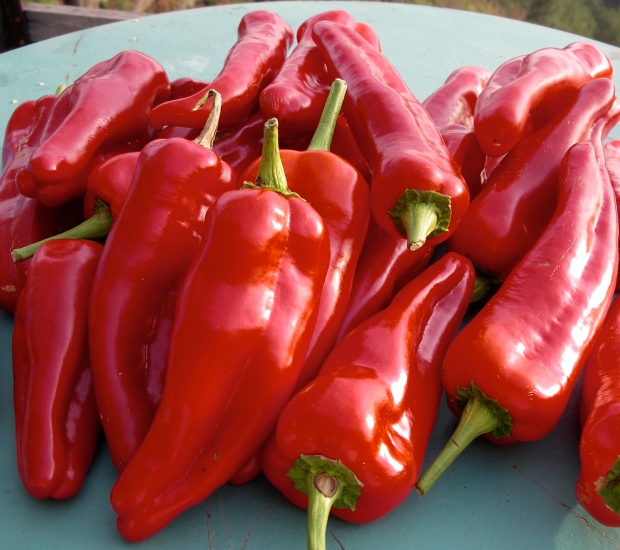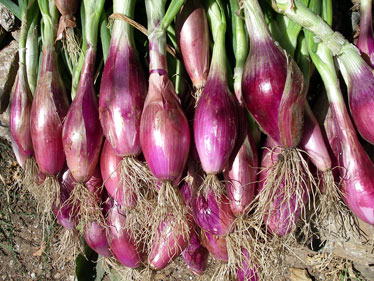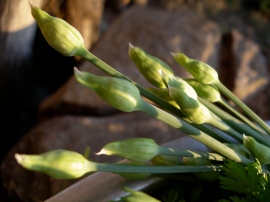Posts Tagged Favourite Varieties
Pepper, Doux D’Espagne
Posted by Laura Hudson in Capsicum, Varieties on April 27, 2012
Capsicum Annuum Doux D’Espagne
A long, sweet pepper also known as Sweet Spanish Mammoth an heirloom, which dates back to 1859, according to Thomas Etty.
I first grew this pepper in 2006 and it did so well, providing huge crops of delicious sweet peppers, that I have grown it each year since. I usually grow 6-12 plants, because I make a lot of pepper preserves, but if I was just growing it for eating fresh I would probably only need 3 to 6 plants.
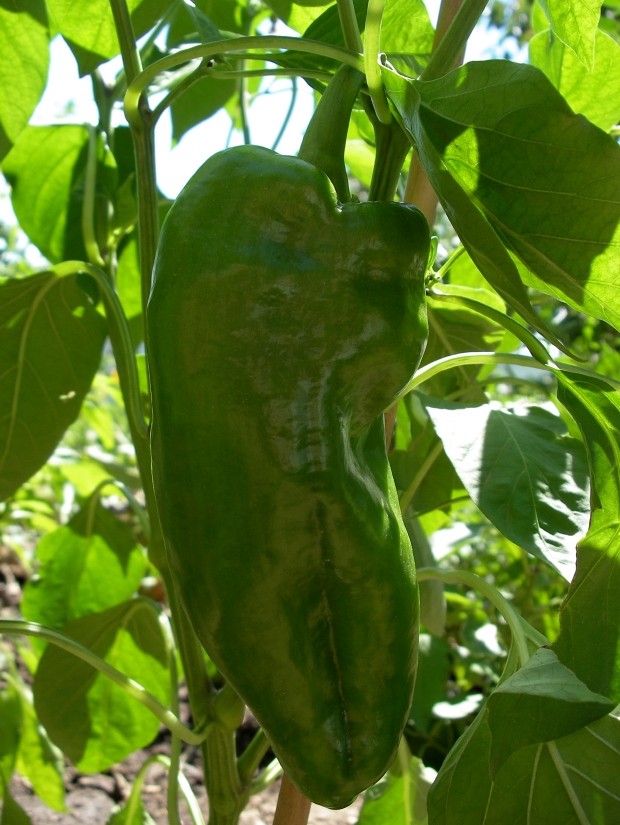 Image Doux D’Espagne, green
Image Doux D’Espagne, green
So far it has seen off all competition, Big Banana an F1 that struggled to produce fruit in a dry season, Red Goats Horn (Corno di Torro) not nearly as meaty or tasty, and Buran nice but not much of a crop. Doux D’Espagne is my favourite by far and the sweet red pepper to measure others by. It really is outstanding, great in the kitchen and a prolific and reliable cropper. Green the fruit are delicious sweet and crisp with a hint of aniseed in the taste, once matured to red they are sweet and packed with flavour. They are delicious raw and make a wonderful Turkish Red Pepper Paste, or Roast Pepper Salad and contribute bulk to hot Harissa.
Image pepper growing in the lush foliage
The plants are robust and grow fairly tall, 3-5 foot depending on the season, with lots of mid to dark green foliage. The white flowers set green fruits that mature to red fairly early and crop until the first frost. The peppers are huge, 20cm long, 3 sided, tapered and smooth. The flesh is thick, crisp and juicy. A great all purpose sweet red pepper, I haven’t found anything to beat it yet, though I do still keep trying.
Overwintering
I have had success growing this variety as a perennial in my unheated polytunnel. It survived and cropped for three seasons before I had to remove the huge plant when the polytunnel had an overhaul and clean out in 2008.
Seed Source Original seed source was a French commercial seed company Gondian.
MDD Growing Log
2006 S:Feb 3 Set out 16 plants May 15, brilliant crop outdoors from early August, pest free. Block planted, mulched with straw they seemed to really like that
2007 S: March 26 Set out 6 plants May 20, excellent crop
2008 S: April 7 Set out 6 plants July 4, cropped ok but not enough time to mature and fully crop as in previous years
2009 S March 5. Pricked out 12 plants April 20. Set out 8 plants May 31. Great crop but would have benefitted from moving schedule forward 1 month as in 2006.
Original Seed Source Gondian
Note this is part of a series on favourite varieties ones that I will continue to grow, save seeds and hopefully produce enough seeds to share. Keeping a variety log is useful particularly if you want to save the seeds .
Endangered Seed Status
According to the Canadian Seeds of Diversity Heritage Plants Database this pepper is an endangered one as few seed companies carry it and it is not maintained in the US or Canadian gene bank. However I have found several companies that carry seeds: Thomas Etty-UK, Vilmorin-FR, Gondian-FR
Mas du Diabl;e Original Posted 7/2/2009
Rouge de Florence
Posted by Laura Hudson in Alliums, Onion on February 9, 2012
Description Rouge de Florence, is also known variously as; Rossa di Firenze, Rossa Lunga Di Firenze, Rossa di Toscana, Long Red Florence, Florence Simiane, Italian Torpedo or Italian Red Torpedo. An outstanding long, red onion that I find a joy to both grow and to eat. I love this onion, the shape the colour and the outstanding flavour. In my garden it is one of the easiest and most reliable of croppers and can be grown right through the year. It stores quite well and can be used raw or cooked so this variety definitely makes it to my list of desert island veg.
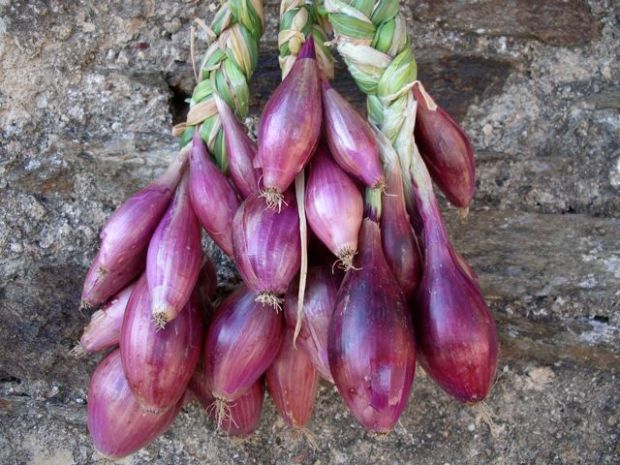 The torpedo shaped bulbs have a deep purple red colour and robust flavour. According to the seedsman Thomas Etty this onion may be synonymous with the Ox-horn Onion or spindle shaped onion (ognon Corne de Boeuf) listed by Vilmorin in The Vegetable Garden, 1885 however I would disagree with M.Vilmorin who thinks that … ‘These [pear shaped] varieties, however, are more curious than useful’. In my opinion this is a really cracking onion for the home or cook’s garden.
The torpedo shaped bulbs have a deep purple red colour and robust flavour. According to the seedsman Thomas Etty this onion may be synonymous with the Ox-horn Onion or spindle shaped onion (ognon Corne de Boeuf) listed by Vilmorin in The Vegetable Garden, 1885 however I would disagree with M.Vilmorin who thinks that … ‘These [pear shaped] varieties, however, are more curious than useful’. In my opinion this is a really cracking onion for the home or cook’s garden.
Origin & History This is an old variety from Tuscan Italy which I think dates back to the 1800’s.
Flavour The flavour can be mild and delicious raw but it can also become quite pungent depending on the year and how the weather effects growth. I find some years these onions are stronger than others.
CultivationSow outdoors in early spring for a summer crop or late summer for a spring crop the following year. Sow undercover from winter and transplant in early spring spacing seedlings 5cm-8cm apart in rows 30cm apart. In my garden I have had the best results sowing in trays in November, pricking out into double trays in December-January and planting out late February -March to harvest a bumper crop after midsummer.
Plants are strong and reliable growers bulbing up nicely after midsummer. They withstand light frost, heavy frost seems to make them divide, drought and heat.
Harvest Grow in succession for use fresh – 2 sowings July-Nov and March-May will provide a continuous supply. For early spring onions leave some onions in the ground over winter and harvest the new green onions that are produced as spring arrives. Harvest when tops have died down and dry as for bulb onions, see my post on Harvesting & Storing onions. Rouge de Florence will store for about 6 months.
Use I use these onions for everything, you can even pickle the small ones.
Resistance a really easy going onion that will grow in poor soil and in tough conditions. An unstoppable onion.
USP When left in the ground overinter I’ve found that these onions multiply to form clumps of 4 or 5 green onions in the spring. These new green onions can be used as spring onions and are delicious.
Grown at Mas du Diable 2005, 2006, 2007, 2008, 2009, 2010
Seed Source Franchi
Note seed sources generally recommend to Sow Feb-May in cool areas and in warmer areas sow from Sept to April to harvest April – Sept outdoors.
Kale, Black Tuscan
Posted by Laura Hudson in A-Z Edibles, Brassicas, Varieties on February 9, 2010
Kale, Borecole or Colwort, Brassica oleracea var. acephala
Cruciferae [Brassicaceae] commonly known as the mustard family
A Lacinated kale also referred to as Nero di Toscano, Cavolo Nero, palm or dinosaur kale. This is one of my all time favourite winter greens and to my mind one of the best winter greens you can grow. A hardy plant that, like most Kales, produces lush leaves during the cooler months, growing sweeter after frosts. The leaves of this variety are long and blistered, with the crinkled edges turning inward. The leaves are a dark green that get darker, almost black, the colder it gets.
Origin Kales are non heading cabbages and one of the oldest forms of cultivated brassica. It is often described as primitive possibly because it is little changed and most closely related to the wild brassica ancestor whose origins appear to be the eastern Mediterranean regions. It is thought to have been used as a food crop as early as 2000 B.C and known to have been cultivated in Europe, by the early Greeks and later Romans, and then spread to other parts of the World. Today Kales represent a species of leafy greens with a great deal of diversity. This variety is from Italy where it was developed in Tuscany, probably during the 18th century. Vilmorin in 1885 describes the Italian Cavolo Nero as being similar if not the same as a variety known as Chou Palmier (palm cabbage) grown in France at that time, but described as tall and not going to flower until its third year.
Propagation Sow in a seed bed in mid to late spring and plant out in summer 6-8 weeks later. Choose a cloudy or rainy day or provide temporary shade for the first week, if the weather is hot, to give the young plants a chance to settle. Plant deeply right up to the first leaves to provide good support. Plant in rows or blocks at a spacing of 30-45cm apart for large plants or 20cm for smaller ones. Care hoe between plants and provide ground cover with an organic mulch to retain moisture and liquid feed in spring to encourage fresh growth. Note I’ve grown this Kale here for the last 5 years and some years it performs much better than others probably to do with the dry heat but it is most badly affected by delaying planting out (I’ve sometimes delayed more than a whole month waiting for a dull day to transplant but I think it is better to plant out even when conditions are not good and provide shade and moisture than delay and leave it in the seedbed too long, this years Kale did not get planted until mid September and it is pretty stunted). I would generally aim to get winter brassicas planted in July and certainly before mid August. For those in cooler climates this kale should do very well.
Crop These kales are hardy up to at least minus 10c (15F) and stand a long time ready to crop, over 5 months in my garden, from late Autumn right through heavy winters to early spring. Harvestingdiscard any older yellowing leaves (these won’t taste good) and pick leaves as needed by pulling downwards against the stem. Flower spikes are sent up in spring and, if caught at the right moment, make delicious spring sprouting-broccoli-like greens.
In the Kitchen
Absolutely delicious simply steamed, pan fried with garlic, or boiled then seasoned with butter. It is a versatile green and can be added to soups such as Ribollita or cooked in sauces such as Indonesian pepper sauce. People often advocate eating this kale raw, but personally I don’t like it. I think its flavour is enhanced by brief cooking, as little as 3 minutes in a wok or pan of hot water makes all the difference, just until the green intensifies.
Further Reading
Kale: The Phytonutrient Master
Herbs for the Kitchen – East Asian
Posted by Laura Hudson in A-Z Edibles, Citrus, Herbs on December 11, 2009
I try to grow most of what I need for the kitchen and this group of herbs are a little bit special because they are all essential ingredients for South East Asian cooking and some of my favourite foods. Luckily most of these are pretty easy to grow and can fit in well with our Mediterranean garden with only a little extra protection.
 Chillies
Chillies
Capsicum: Annum, Chinense, Baccatum, or Pubescens
Not a herb of course but Chillis are indispensable in my kitchen, for all kinds of food but particularly East Asian, so I grow a wide variety of hot, medium and mild peppers. Chillis can be used fresh or dried, whole, pureed or powdered and all lend a different taste and quality to a dish. I sow Chillis in heat from November-March, set out undercover in March-April and outdoors in May. They can be harvested (depending on variety and protection) from April right through until the first frosts. Chillis store well whole or powdered once dried or they can be frozen fresh for use during the year. Use in pretty much everything.
Oriental Chives (Garlic Chives)
These delicious allium leaves are a close relative of ordinary chives but the taste is so much better that I no longer bother growing chives. The long flat leaves have pleasantly hot sweet garlic flavour and the flower buds are a delicacy, crisp and delicious. Once you get a clump started these plants are perennial and are in flower July-August. Sow spring or autumn and divide in autumn. I love this stuff so much I’ve got a 40ft row of it. Use The leaves and flower buds are lovely in soups, salads, stir fries or as crudités.
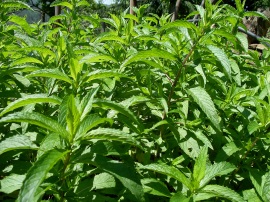 Mint
Mint
Mentha Piperita
Mint is one of the most versatile herbs we use it in all kinds of dishes; salads, noodles, soups, and puddings and not just East Asian inspired food. I grow a variety called Menthe Douce or Mentha Anglaise in France but we would know it as Peppermint. Mint can be propagated from seed or by division. Mint, on our land is best in spring and autumn, in the hot summer months it can get tough and nasty so I cut it back in late July and it re-generates providing a late crop of fresh leaves late summer through autumn. Use a really versatile herb that can be added to to sweet or savory foods, fresh or dried to enhance teas, cordials, ice-creams, puddings, chutneys, salads and riatas.
Thai Basil
Thai basil, also known as Thai purple basil, Asian basil, Anise basil is a magnificent plant; nice and bushy with pointed green leaves and purple stems and flowers. The leaves are delicious providing a strong, hot aniseedish flavour. It is most commonly used in Thai cooking where it is stir fried or added to salads, soups and curries. It is also deep fried and used as a garnish. Thai basil is grown much in the same way as European basil. I start the seeds off undercover in cells, usually March, then plant out when the weather is warm enough, usually April-May.
Use mainly Thai and Vietnamese cuisine, fresh or deep fried as a garnish
Coriander
Coriandrum sativum
I grow coriander also known as cilantro for both seed and the leaf. Coriander is a delicate leafy herb that goes to seed easily so for leaf production it needs to be sown regularly through the year. I sow direct undercover October-February and outdoors March to September. I find it best to sow in half rows direct into a well watered drill with a light covering of sieved soil. To aid germination some gardeners recommend that coriander seeds should be lightly cracked. To do this rub the seeds between two flat stones or put them in a small plastic bag and crush with a smooth heavy object, before sowing. I find the seed does germinate well without the need for cracking. Green Coriander Seeds are one of my favourite spices so once I have finished harvesting leaves I leave the plants to grow on to produce seed and use some green in the kitchen then dry the rest for re-sowing and using in the kitchen.
Lemon Grass
Cymbopogon flexuosus
Tender perennial native to Cambodia, India, Sri Lanka, Burma,and Thailand, also known as East-Indian Lemon Grass, Cochin Grass or Malabar Grass. Lemon grass grows in grassy clumps and looks a little like pampas grass. I got started with a clump of Lemon Grass, which was given to me by our lovely Auzzie helpers, Graham & Renee in 2006, and really growing well in the polytunnel. I also grow a clump from seed which is also growing in the tunnel. Once the stalks are large enough they can by snapped off as needed. If the temperatures drops below 4c they will need protection. Last winter the temperature, in the unheated tunnel, was too cold and the clump got frost bite and rotted back. I cut out as much rotten material as I could and waited, fingers crossed. In spring the clump came back to life and is now romping away again but lesson learnt. This winter I will make a special winter jacket for it of sacking stuffed with straw. Use finely chopped or left whole to flavour steamed dishes, soups, stir-fries and it also makes a delicious tea.
Vietnamese Coriander
Polygonum odoratum
Also known as Vietnamese Mint, Cambodian Mint or Laksa Leaf. A tender perennial. Most commonly used in Vietnamese cooking in salads, soups and spring rolls it adds an aromatic heat reminiscent of mint, coriander but much stronger and hotter with a hint of lemon. In Malaysia and Singapore it is called Laska leaf and is essential to the soupy noodle dish it is named after. Propagation can only be done by division. I started with one small plant in spring 2007, which grew madly in the polytunnel. However because this herb cannot be grown from seed I’d bought a plant to start with from a herb specialist but – disaster- the plant carried with it mealy bug in the soil which thrived in the tunnel and devistated not only the Laksa but everything else growing in the tunnel in 2008. I’ve lost the herb in fact I had to burn the whole thing, roots soil and everything to get rid of the bugs and the tunnel is still not back into proper use. I will have to start over with this herb once I can find another source for the plant.
Kaffir Lime
Citrus Hystrix
Kaffir lime leaves and juice are an essential ingredient in Thai curries, Asian soups and some stir fry dishes. The leaves are very aromatic and are used fresh whole or shredded. The limes make a lovely pickle and the juice is a strong souring agent. I have a small tree growing in a pot, which my nieces bought me, and this does need a little bit of special care see growing citrus fruit in pots.
Originally posted on Mas du Diable 31/7/2008 it is here updated and republished.
Seeds and Starts
I am hoping to expand on what I grow and try galangal, ginger, nigella, curry leaves, sacred basil, which I think is Ocimum tenuiflorum (Sanctum) and Holy Basil is Ocimum Basilicum (Horapha). So if anyone has any seeds or starts for any of these I’d love to hear from you.
